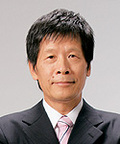Messages from Keidanren Executives and Contributed articles to Keidanren Journals March, 2014 Pressing Business Environments: The Mother of Process Innovation

After World War II, Japan's steel industry aggressively focused on process innovation and came to lead global technology in only 30 years. This was a result of efforts made by a large number of predecessors, but we must not forget the fact that it was also a result of the pressing economic environment faced by Japan at that time.
Steel was an essential industrial material to restore a completely destroyed Japan. That is why people often said, "Steel is rice for industry." Steel production is composed of several processes: Smelting iron ore in a blast furnace, removing impurities (refining), casting steel in molds, and rolling it into finished shapes. The steelmaking process that supported the U.S., which was an advanced industrial country at that time, was standardized as a combination of a medium-sized blast furnace and non-continuous, independent processes.
In those days, however, huge investment was needed to introduce the steelmaking process directly from the U.S., and Japan could not afford it. Japan was placed under pressure and had no other means than to develop an innovative process by dramatically improving production efficiency and significantly reducing capital investment. The Japanese steel industry tried ideas that had yet to be industrialized at that time, regarding process innovation, such as construction of larger blast furnaces, refining in a BOF converter furnace instead of an open-hearth furnace, and continuous casting and rolling. The goals were surmounted, and through this, the industry came to lead global technology.
On the other hand, the U.S. had little incentive to shoulder the risk of attempting new processes, as it already had a sufficient, standardized manufacturing capacity. This enabled Japan to get ahead of the U.S. quickly.
Today, it is not very difficult for steelmakers around the world to produce tolerable products by purchasing, from hardware manufacturers, steelmaking machines that were established and standardized by Japan. A steel industry can differentiate its competitiveness only to a limited extent, unless it differentiates the manufacturing process decisively.
Needless to say, we must win in actual daily competition. However, our challenges now regard how to create a driving force toward process innovation that allows Japan to pull away from followers and how to provide the pressing environment in current stable society.
Virtually creating a surge that is similar to what Japan's steel industry was forced to enter after World War II may be a common challenge not only for the steel industry but for all types of businesses.
Japan needs to mobilize all capacities from industry, academia, and government to tackle the challenge.
